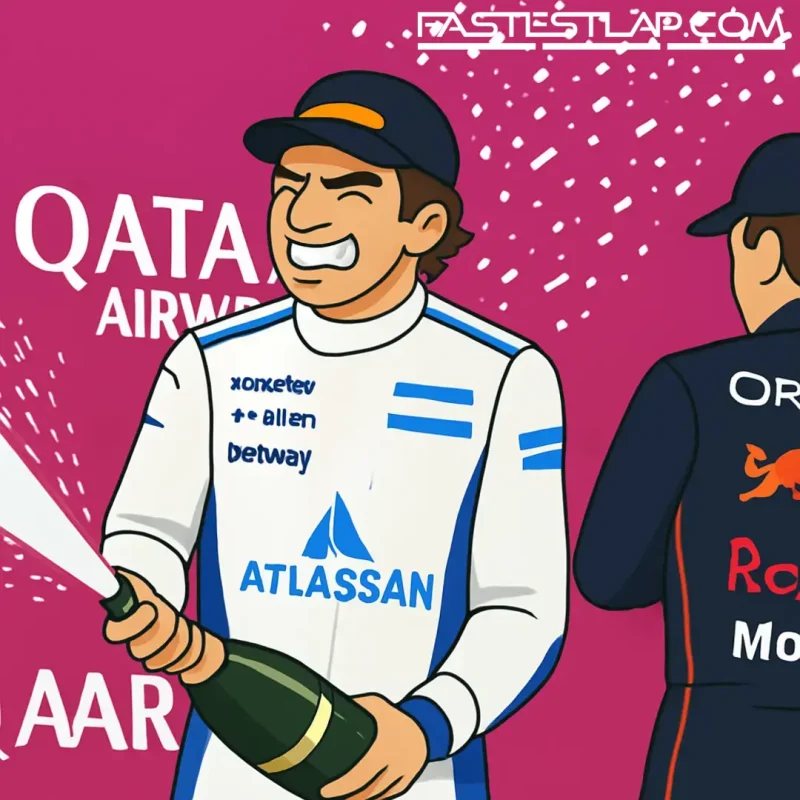Carlos Sainz’s Baku podium wasn’t just another shiny bottle of champagne for Williams. It felt like a line in the sand. A win for a long rebuild. And, if you ask Jacques Villeneuve, a reminder that Sainz is the guy who quietly drags entire organisations forward.
The 1997 World Champion has never been shy with an opinion, and he sees a clear pattern to Sainz’s career: give him a few months in a new environment, and everything around him starts to click. Villeneuve reckons that’s exactly what we’re seeing at Williams this season — and, pointedly, what Ferrari have been missing since Sainz left Maranello at the end of 2024.
“He’s always been mature and strong,” Villeneuve said to a betting outlet, challenging the old trope that Sainz lacks outright speed. The Canadian’s view isn’t romantic; it’s process-driven. Sainz joins, spends half a season stitching himself to the fabric of the team, and the level rises. That was the playbook at Renault. It was the story at McLaren. It was a theme at Ferrari. And it’s surfacing again at Grove.
James Vowles flagged those traits when he signed Sainz to a multi-year deal. Adaptability. Gold-standard feedback. A steady hand for a team that needed one. The Spaniard didn’t explode out of the blocks against Alex Albon in the early races, but the trend since the break has pointed only one way. The podium in Baku, threaded through a tidy race and hard-earned pace, was the payoff.
Villeneuve goes further. He argues that Sainz’s graft often lifts his teammate’s level too — sometimes making the other car a fraction quicker before Sainz inevitably turns the tide back. And while Charles Leclerc’s peaks at Ferrari were broadly higher, Villeneuve’s view is that the intra-team balance wasn’t as one-sided as some chose to remember. In his words, “every time he left a team, that team went downhill.” He puts Ferrari in that same bucket right now.
That’s the sting. Ferrari, who re-signed Fred Vasseur for continuity and looked primed to steady the ship, haven’t exactly nailed their post-summer run-in. Monza was circled in red as a home banker and didn’t deliver. Baku — a circuit that’s usually generous to Leclerc — turned into one of the Scuderia’s rougher weekends of the year. It’s two bruises in quick succession, and it leaves Maranello chasing. Heading to Singapore, Ferrari sit third in the Constructors’ standings, narrowly behind Mercedes.
None of this is fatalistic. Villeneuve concedes Ferrari could yet be perfectly placed for 2026 when F1’s new rules reset the order again. Lewis Hamilton and Leclerc, on paper, is a formidable pairing for a clean-sheet era. But right now, the more compelling story is the contrast: Ferrari drifting, Williams finding a pulse with Sainz at the centre of it.
What’s changed at Grove? It isn’t just headline speed. It’s the texture of the weekends. Fewer unforced errors. A car that responds to a narrower window of setup tweaks. Strategy calls with teeth. The sort of incremental, unglamorous gains that arrive when a driver can translate what he feels in the seat into what the engineers can do overnight. Sainz is a translator by trade.
There’s also the competitive reality of the 2025 grid. Margins are cruel. Williams don’t need to reinvent the wheel to steal big results; they need consistency and a driver who can cash in on messy Sundays. Sainz has built a reputation on exactly that. He’s not a headline chaser; he’s a points accumulator who shows up with a plan.
Ferrari, meanwhile, have to make the next two races count — not for the trophy cabinet, but for the mood. That Vasseur extension was designed to lower the temperature and give the project breathing room. The on-track product has to follow. It’s not hard to imagine both Ferrari drivers setting the tone again in Singapore. It’s just that, right now, Williams have a driver setting a different kind of tone — one that sounds a lot like progress.
Sainz’s podium in Baku won’t change the championship picture on its own. But it’s a marker. For Williams, it validates the hire. For the rest of the paddock, it’s a reminder: development isn’t just about wind tunnels and CFD. Sometimes it’s about the bloke who shows up, listens, and makes the whole room smarter.
Villeneuve’s take may be blunt, but it’s not baseless. Look across Sainz’s career and you see the footprint he leaves behind — a bit more structure, a bit more certainty, a teammate scarred by the fight. Williams will take all of that. And if Ferrari are indeed in a dip as the Canadian suggests, the optics are awkward.
Then again, there’s a reason people keep betting on Ferrari’s horizon. The talent is there. The resources, the leadership, the all-star driver lineup. If they turn the corner quickly, we’ll be talking about a blip, not a trend.
Until then, Williams have their moment — and Sainz has his proof of concept.




